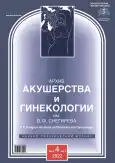Morphological features of the endometrium in patients with atrophic chronic endometritis and impaired hemodynamics
- Authors: Gazizova G.K.1, Yashchuk A.G.1, Maslennikov A.V.1, Dautova L.A.1, Battalova G.Y.1
-
Affiliations:
- Bashkir State Medical University
- Issue: Vol 9, No 4 (2022)
- Pages: 231-237
- Section: Original study articles
- URL: https://journal-vniispk.ru/2313-8726/article/view/120403
- DOI: https://doi.org/10.17816/2313-8726-2022-9-4-231-237
- ID: 120403
Cite item
Full Text
Abstract
BACKGROUND: Chronic endometritis is a clinical and morphological syndrome in which, due to persistent endometrial damage to the endometrium by an infectious agent, multiple secondary morphofunctional changes occur that impair cyclic transformation and receptivity of the uterine mucosa.
AIM: This study aimed to reveal morphological features of the endometrium in patients with atrophic chronic endometritis and impaired hemodynamics in the endometrium.
MATERIALS AND METHODS: The study involved 86 female patients divided into two groups. Group 1 comprised 44 patients with chronic endometritis and impaired endometrial hemodynamics. Group 2 included 42 patients with chronic endometritis without impaired microcirculation in the endometrium. The patients underwent endometrial pipelle biopsy for histological and immunohistochemical examination to determine the expression of VEGF, TGF-β and CD138 during the proliferative phase of the menstrual cycle.
RESULTS: Histological examination revealed vascular sclerosis, plasma cells, inflammatory infiltrates, stromal fibrosis, granulomas, and hemorrhagic foci in patients with atrophic chronic endometritis and impaired hemodynamics.
CONCLUSIONS: While examining the morphological picture of atrophic chronic endometritis with impaired hemodynamics, the formation of scar tissue was noted resulting in impaired blood circulation, which leads to focal hemorrhages in the uterine mucosa. According to immunohistochemical analysis, patients with impaired endometrial hemodynamics showed a statistically significant decrease in VEGF and an increase in TGF-β expression, which indicates the severity of fibrosis.
Full Text
##article.viewOnOriginalSite##About the authors
Gulnaz Kh. Gazizova
Bashkir State Medical University
Author for correspondence.
Email: karamelka5@inbox.ru
ORCID iD: 0000-0001-9529-3747
assistant
Russian Federation, Ufa, Republic of BashkortostanAlfiya G. Yashchuk
Bashkir State Medical University
Email: alfiya_galimovna@mail.ru
ORCID iD: 0000-0003-2645-1662
MD, Dr. Sci. (Med.), Рrofessor
Russian Federation, Ufa, Republic of BashkortostanAnton V. Maslennikov
Bashkir State Medical University
Email: mas-anton@yandex.ru
ORCID iD: 0000-0002-1349-747X
MD, Cand. Sci. (Med.), assistant professor
Russian Federation, Ufa, Republic of BashkortostanLiliana A. Dautova
Bashkir State Medical University
Email: lil.d5@yandex.ru
ORCID iD: 0000-0002-8281-5515
MD, Cand. Sci. (Med.), assistant professor
Russian Federation, Ufa, Republic of BashkortostanGyuzel’ Yu. Battalova
Bashkir State Medical University
Email: karamelka5@inbox.ru
ORCID iD: 0000-0002-1641-9952
MD, Dr. Sci. (Med.), Рrofessor
Russian Federation, Ufa, Republic of BashkortostanReferences
- Shurshalina AV. Khronicheskiy endometrit kak prichina narusheniy reproduktivnoy funktsii. Gynecology. 2012;14(4):16–18. (In Russ).
- Unanyan AL, Kossovich YM. Modern approaches to the management of patients with chronic endometritis. V.F. Snegirev Archives of Obstetrics and Gynecology. 2016;3(3):141–148. (In Russ). doi: 10.18821/2313-8726-2016-3-3-141-148
- Tabolova VK, Korneeva IE. Vliyanie khronicheskogo endometrita na iskhody programm vspomogatel’nykh reproduktivnykh tekhnologii: morfo-funktsional’nye i molekulyarno-geneticheskie osobennosti. Obstet Gynecol. 2013;(10):17–22. (In Russ).
- Simon C. Introduction: Do microbes in the female reproductive function matter? Fertil Steril. 2018;110(3):325–326. doi: 10.1016/j.fertnstert.2018.06.041
- Maged AM, Kamel AM, Abu-Hamila F, et al. The measurement of endometrial volume and sub-endometrial vascularity to replace the traditional endometrial thickness as predictors of in-vitro fertilization success. Gynecol Endocrinol. 2019;35(11):949–954. doi: 10.1080/09513590.2019.1604660
- Kavurmacı SA, Sahin G, Akdogan A, et al. Evaluating the role of endometrial colour Doppler dynamic tissue perfusion measurements in in vitro fertilisation success. J Obstet Gynaecol. 2022;42(5):1305–1311. doi: 10.1080/01443615.2021.1960292
- Abraham S, Sanjay G, Majiyd NA, et al. Encapsulated VEGF121-PLA microparticles promote angiogenesis in human endometrium stromal cells. J Genet Eng Biotechnol. 2021;19(1):23. doi: 10.1186/s43141-021-00118-1
- Wei Z, Han C, Li H, et al. Molecular Mechanism of Mesenchyme Homeobox 1 in Transforming Growth Factor β1-Induced P311 Gene Transcription in Fibrosis. Front Mol Biosci. 2020;(7):59. doi: 10.3389/fmolb.2020.00059
- Liu L, Yang H, Guo Ya, Yang G, Chen Yu. The impact of chronic endometritis on endometrial fibrosis and reproductive prognosis in patients with moderate and severe intrauterine adhesions: a prospective cohort study. Fertil Steril. 2019;111(5):1002–1010.e2. doi: 10.1016/j.fertnstert.2019.01.006
Supplementary files













